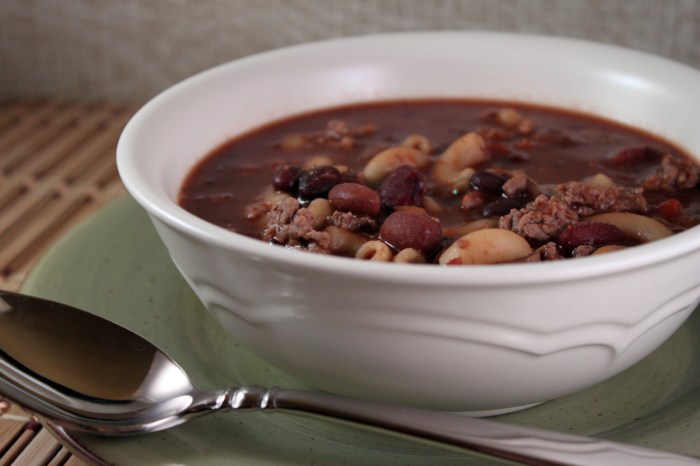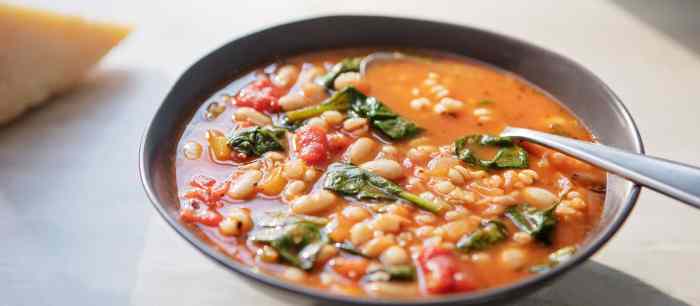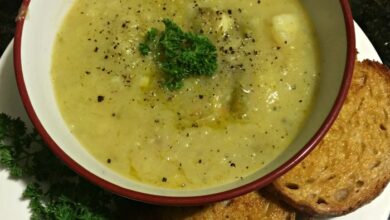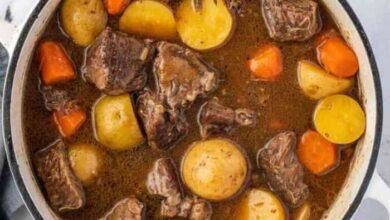
Italian Style Winter Soup: Comforting Flavors of the Season
Italian style winter soup is more than just a meal; it’s a warm hug on a chilly day. Imagine the aroma of simmering vegetables, herbs, and beans filling your kitchen, the rich broth coating your spoon, and the comforting flavors of home.
It’s this very essence that makes Italian winter soups so beloved, a tradition passed down through generations.
From the hearty minestrone to the rustic ribollita, each soup tells a story of Italian culinary heritage, reflecting the season’s bounty and the desire for warmth and nourishment. These soups are a symphony of textures and tastes, a celebration of fresh, seasonal ingredients that are as much about the heart as they are about the stomach.
Italian Style Winter Soup
Italian cuisine is renowned for its emphasis on fresh, seasonal ingredients, creating dishes that are both flavorful and comforting. Winter in Italy is a time for hearty and warming soups, often featuring root vegetables, legumes, and flavorful broths. These soups are not only delicious but also provide a comforting and nourishing meal on cold winter days.
Popular Italian Winter Soups
Italian winter soups are known for their depth of flavor and comforting qualities. Here are some popular examples:
- Minestrone: This classic Italian soup is a staple of winter cuisine. It typically features a variety of vegetables, including beans, tomatoes, carrots, celery, potatoes, and pasta. Minestrone is a versatile soup that can be customized with different vegetables and ingredients based on personal preference and seasonal availability.
- Ribollita: This Tuscan soup is made with bread, vegetables, and beans. It is traditionally cooked in a large pot and served with a generous dollop of olive oil. Ribollita is known for its hearty texture and rustic flavors.
- Pasta e Fagioli: This soup is a combination of pasta and beans, often with tomatoes and vegetables. It is a simple and satisfying soup that is perfect for a cold winter evening. Pasta e Fagioli is a popular dish in many regions of Italy.
Key Ingredients and Flavors
Italian winter soups are a culinary delight, bursting with vibrant flavors and textures. They are known for their hearty and comforting nature, perfect for warming you up on chilly evenings. The key to their deliciousness lies in the careful selection of ingredients, each contributing its unique flavor profile to create a symphony of taste.
Ingredient Breakdown
The ingredients used in Italian winter soups are diverse, ranging from vegetables and beans to grains and herbs. Each ingredient adds a distinct dimension to the soup’s overall flavor and texture.Here’s a table that breaks down some common ingredients, their characteristics, and their flavor profiles:
| Ingredient | Description | Flavor Profile | Example Soup |
|---|---|---|---|
| Tomatoes | Ripe, juicy tomatoes add a sweet and tangy flavor to the soup. | Sweet, tangy, acidic | Minestrone |
| Garlic | Aromatic garlic cloves impart a pungent, savory flavor that enhances the overall taste of the soup. | Pungent, savory, slightly bitter | Ribollita |
| Onion | Sweet onions add a subtle sweetness and a depth of flavor to the soup. | Sweet, savory, slightly pungent | Pasta e Fagioli |
| Basil | Fresh basil leaves provide a bright, herbaceous flavor that complements the other ingredients. | Fresh, herbal, slightly peppery | Minestrone |
| Oregano | Dried oregano adds a warm, earthy flavor to the soup. | Warm, earthy, slightly bitter | Ribollita |
| Beans | Various types of beans, such as cannellini, borlotti, and kidney beans, provide a hearty texture and a rich, earthy flavor. | Earthy, creamy, slightly sweet | Pasta e Fagioli |
| Grains | Rice, barley, or pasta add a starchy texture and a subtle flavor to the soup. | Starchy, neutral, slightly sweet | Minestrone |
Popular Italian Winter Soup Recipes
Italian winter soups are a comforting and flavorful way to warm up on chilly evenings. They often feature hearty ingredients like beans, vegetables, and pasta, creating a satisfying and nourishing meal. Here are a few popular Italian winter soup recipes that you can try at home.
Popular Italian Winter Soup Recipes
These recipes offer a glimpse into the diverse world of Italian winter soups. Each one has its unique character and flavor profile, making them perfect for different tastes and preferences.
| Soup Name | Ingredients | Preparation Steps | Serving Suggestions |
|---|---|---|---|
| Minestrone |
|
|
|
| Ribollita |
|
|
|
| Pasta e Fagioli |
|
|
|
Variations and Adaptations

The beauty of Italian-style winter soups lies in their adaptability. These soups can be customized to suit regional variations and personal preferences, making them a versatile dish for any occasion.
Regional Variations
Regional variations in Italian-style winter soups often reflect the local ingredients and culinary traditions. For example, in Tuscany, soups might feature hearty beans like cannellini or borlotti, while in Emilia-Romagna, they might include pancetta or other cured meats. Northern regions might incorporate more dairy products, such as cream or Parmesan cheese, while southern regions might favor tomatoes and chili peppers.
Personal Preferences
Beyond regional variations, personal preferences play a significant role in customizing Italian-style winter soups. Adding different types of pasta, beans, or meats can easily transform a basic recipe into something unique. For instance, a simple minestrone can be enhanced with the addition of ditalini pasta, orzo, or even small pasta shapes like stelline.
Different beans, such as chickpeas, lentils, or white beans, can add texture and flavor, while meats like sausage, chicken, or beef can provide a protein boost.
Dietary Restrictions and Allergies
Adapting Italian-style winter soups to dietary restrictions or allergies is relatively straightforward. For example, vegetarians can easily omit meat and substitute vegetable broth for meat broth. Gluten-free options can be achieved by using gluten-free pasta or avoiding ingredients containing gluten, such as breadcrumbs.
Individuals with dairy allergies can use dairy-free alternatives like almond milk or coconut milk, and avoid ingredients like Parmesan cheese.
Serving and Pairing
Italian winter soups are often served as a light and comforting meal, particularly during the colder months. They can be enjoyed as a standalone dish or paired with other foods to create a complete and satisfying meal.The way Italian winter soups are served often reflects regional traditions and preferences.
In some regions, soups might be served in bowls with a generous dollop of freshly grated Parmesan cheese, a drizzle of extra virgin olive oil, or a sprinkle of chopped fresh herbs. Other regions might favor serving the soup with crusty bread, toasted bread croutons, or a side of grilled meats.
Garnishes and Accompaniments, Italian style winter soup
Garnishes and accompaniments play a crucial role in enhancing the flavor and presentation of Italian winter soups. They add visual appeal and provide textural contrast, creating a more satisfying dining experience.Here are some popular garnishes and accompaniments for Italian winter soups:* Fresh herbs:Chopped parsley, basil, oregano, and rosemary are commonly used to add a burst of freshness and aroma to the soup.
Grated cheese
Parmesan cheese is a classic addition to Italian winter soups, providing a salty and savory flavor. Other cheeses like pecorino romano or ricotta can also be used depending on the soup’s ingredients.
Olive oil
A drizzle of extra virgin olive oil adds richness and depth of flavor to the soup.
Bread
Crusty bread, toasted bread croutons, or focaccia are perfect for soaking up the flavorful broth and providing a satisfying texture.
Grilled meats
Grilled sausages, chicken, or fish can be served alongside the soup for a heartier meal.
Wine Pairing
Wine pairings for Italian winter soups should complement the flavors of the soup without overpowering them. The choice of wine will depend on the specific ingredients and flavors of the soup.Here’s a table illustrating some common soup-wine pairings:
| Soup | Garnishes | Accompaniments | Wine Pairing |
|---|---|---|---|
| Minestrone | Parmesan cheese, chopped parsley | Crusty bread | Chianti Classico |
| Ribollita | Olive oil, grated pecorino romano | Grilled sausage | Sangiovese |
| Pasta e Fagioli | Fresh basil, grated Parmesan cheese | Toasted bread croutons | Barolo |
| Zuppa Toscana | Chopped kale, pancetta | Grilled chicken | Pinot Grigio |
Cultural Significance and History: Italian Style Winter Soup

Italian winter soups are more than just a culinary tradition; they represent a deep connection to the land, family, and the resilience of Italian culture. These soups are a testament to the resourceful nature of Italian people, their ability to transform simple ingredients into comforting and nourishing meals.
The Role of Italian Winter Soups in Traditional Cuisine
Italian winter soups are deeply embedded in the fabric of Italian cuisine. They are a staple in traditional family gatherings, particularly during the colder months. These soups offer warmth, comfort, and nourishment, providing a much-needed respite from the harsh winter weather.
Their presence on the table is a symbol of togetherness, family, and the sharing of cherished recipes passed down through generations.
- Family Gatherings:Italian winter soups are often the centerpiece of family gatherings, especially during holidays like Christmas and New Year’s Eve. These occasions are marked by the preparation of elaborate feasts, and soups are an integral part of the multi-course meal, bringing a sense of warmth and unity to the celebration.
- Comfort Food:Italian winter soups are synonymous with comfort food. Their rich, hearty flavors and warming properties provide solace and a sense of well-being during the cold winter months. They are a reminder of simpler times and the importance of family and tradition.
- Resourcefulness:Italian winter soups embody the resourcefulness of Italian cuisine. They are often made with simple, readily available ingredients, like vegetables, beans, and pasta, demonstrating the ability to create nourishing meals from humble beginnings.
Historical Origins and Evolution
The origins of Italian winter soups can be traced back to ancient Roman times, where soups were a common staple in the diet. These early soups were often simple, consisting of vegetables, legumes, and grains, reflecting the agricultural practices of the time.
Over the centuries, Italian winter soups evolved, incorporating regional ingredients and culinary techniques, resulting in the diverse array of soups we see today.
- Ancient Roman Influence:Roman cuisine heavily relied on soups, known as “potages” or “pulmentaria,” which were often made with vegetables, legumes, and grains. These early soups provided sustenance and were a testament to the resourceful nature of the Roman people.
- Medieval and Renaissance Periods:During the medieval and renaissance periods, Italian cuisine continued to evolve, incorporating spices, herbs, and new ingredients from the East. This period saw the emergence of more complex and elaborate soups, often featuring meat, poultry, and seafood.
- Regional Variations:The evolution of Italian winter soups was also influenced by regional variations. Each region developed its own unique soup recipes, reflecting the local ingredients and culinary traditions. For example, the northern regions, with their abundance of dairy products, developed creamy soups like “Minestrone alla Milanese,” while the southern regions, known for their fresh seafood, created hearty fish soups like “Cacciucco.”
Cultural Significance of Specific Soups
Many Italian winter soups hold a special place in the hearts and kitchens of Italian families. These soups are not just recipes; they are stories passed down through generations, imbued with cultural significance and cherished memories.
- Minestrone:This hearty vegetable soup is a quintessential Italian winter soup, known for its versatility and adaptability. It is often considered a symbol of Italian family meals, bringing together generations around the table to share stories and laughter.
- Ribollita:This Tuscan soup, made with bread, vegetables, and beans, is a testament to the resourceful nature of Italian cuisine. It is a perfect example of how simple ingredients can be transformed into a delicious and satisfying meal.
- Pasta e Fagioli:This soup, made with pasta and beans, is a staple in many Italian homes. It is a comforting and nourishing meal, often served during the colder months.
The Art of Cooking Italian Style Winter Soups

Italian winter soups are a culinary symphony of fresh ingredients, aromatic herbs, and comforting flavors. The art of crafting these soups lies in understanding the subtle nuances of each ingredient and how they harmoniously blend to create a truly satisfying experience.
The Importance of Fresh Ingredients
Freshness is paramount in Italian cooking, and winter soups are no exception. Using seasonal vegetables, herbs, and legumes at their peak ripeness will infuse your soup with an unparalleled depth of flavor. Imagine the difference between a soup made with wilted spinach and one bursting with the vibrant green of freshly picked leaves.
The former will be bland, while the latter will be a burst of earthy sweetness. Similarly, using fresh herbs like rosemary, thyme, and sage will add a complex aroma that elevates the entire dish.
The Role of Stock and Broth
Stock and broth are the foundation of any good soup, and Italian winter soups are no exception. They provide the base flavor and act as a vehicle for the other ingredients. A well-made stock or broth will have a rich, complex flavor that enhances the overall taste of the soup.
Creating a Simple, Yet Flavorful, Italian Style Winter Soup Base
Here’s a simple recipe for a classic Italian winter soup base:
Ingredients:
- 1 tablespoon olive oil
- 1 onion, chopped
- 2 carrots, chopped
- 2 celery stalks, chopped
- 4 cloves garlic, minced
- 8 cups vegetable broth
- 1 teaspoon dried oregano
- 1/2 teaspoon salt
- 1/4 teaspoon black pepper
Instructions:
- Heat the olive oil in a large pot over medium heat. Add the onion, carrots, and celery and cook until softened, about 5 minutes.
- Add the garlic and cook for 1 minute more.
- Pour in the vegetable broth, oregano, salt, and pepper. Bring to a boil, then reduce heat and simmer for 30 minutes.
- Strain the broth through a fine-mesh sieve, discarding the solids.
This simple base can be used for a variety of Italian winter soups. Simply add your favorite vegetables, legumes, pasta, or grains to create a delicious and satisfying meal.
The Comforting Power of Soup
There’s a reason why soup is often considered a quintessential comfort food, particularly during the colder months. Its warmth, aroma, and familiar flavors evoke a sense of well-being and contentment that goes beyond mere sustenance. This is especially true for Italian-style winter soups, which are infused with the rich history and traditions of Italian cuisine.
The Science of Comfort Food
The connection between food and comfort is deeply rooted in our biology and psychology. When we consume comforting foods, our brains release neurochemicals like dopamine and serotonin, which are associated with pleasure and relaxation. This, in turn, helps reduce stress, anxiety, and feelings of loneliness.
Soup, with its warm temperature and soothing textures, further amplifies this effect.






